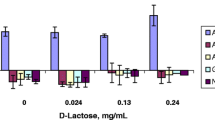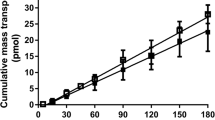Abstract
Purpose. To optimize the conditions for determining Caco-2 permeation of HIV protease inhibitors and other lipophilic compounds, and to compare cyclic urea HIV protease inhibitors with marketed compounds.
Methods. Absorptive and secretory Caco-2 membrane permeation studies were performed with HIV protease inhibitors and various reference compounds, examining the effects of adding the solubilizing agents dimethylacetamide (DMAC) and albumin in donor and reservoir compartments, respectively.
Results. DMAC was useful as an additive in the donor vehicles, increasing the dissolved concentrations of poorly water-soluble HIV protease inhibitors, and enabling more reliable determination of Papp values. Donor vehicles containing up to 5% DMAC could be used without altering Caco-2 barrier function, as indicated by the lack of effect on permeabilities of reference compounds with diverse absorption characteristics. The utilization of a reservoir containing albumin resulted in marked increases in absorptive Papp values for some HIV protease inhibitors as well as other lipophilic, highly protein bound compounds, consistent with albumin increasing the release of these compounds from the cell monolayer.
Conclusions. Poorly soluble, lipophilic, highly bound compounds may require using solubilizing agents in the donor and reservoir compartments of Caco-2 permeation experiments for estimating in vivo absorption potential. If the reservoir does not provide adequate sink conditions, cellular retention could over-emphasize the contributions of secretory transport. The cyclic ureas, DMP 450, DMP 850, and DMP 851, have Caco-2 permeabilities suggestive of moderate-to-high oral absorption potential in humans.
Similar content being viewed by others
REFERENCES
Centers for Disease Control and Prevention. Report of the NIH panel to define principles of therapy of HIV infection and guidelines for the use of antiretroviral agents in HIV-infected adults and adolescents. MMWR 47 (No. RR-5) (1998).
P. Y. S. Lam, P. K. Jadhav, C. J. Eyermann, C. N. Hodge, Y. Ru, L. T. Bacheler, J. L. Meek, M. J. Otto, M. M. Rayner, Y. N. Wong, C.-H. Chang, P. C. Weber, D. A. Jackson, T. R. Sharpe, and S. Erickson-Viitanen. Rational design of potent, bioavailable, nonpeptide cyclic ureas as HIV protease inhibitors. Science 263:380–384 (1994).
J. H. Lin. Human immunodeficiency virus protease inhibitors–from drug design to clinical studies. Adv. Drug Del. Rev. 27:215–233 (1997).
M. Longer, B. Shetty, I. Zamansky, and P. Tyle. Preformulation studies of a novel HIV protease inhibitor, AG1343. J. Pharm. Sci. 84:1090–1093 (1995).
D. J. Kempf, H. L. Sham, K. C. Marsh, C. A. Flentge, D. Betebenner, B. E. Green, E. McDonald, S. Vasavanonda, A. Saldivar, N. E. Wideburg, W. A. Kati, L. Ruiz, C. Zhao, L. Fino, J. Patterson, A. Molla, J. J. Platner, and D. W. Norbeck. Discovery of ritonavir, a potent inhibitor of HIV protease with high oral bioavailability and clinical efficacy. J. Med. Chem. 41:602–617 (1998).
G. A. Sawada, N. F. H. Ho, L. R. Williams, C. L. Barsuhn, and T. J. Raub. Transcellular permeability of chlorpromazine demonstrating the roles of protein binding and membrane partitioning. Pharm. Res. 11:665–673 (1994).
R. B. Kim, M. F. Fromm, C. Wandel, B. Leake, A. J. J. Wood, D. M. Roden, and G. R. Wilkinson. The drug transporter P-glycoprotein limits oral absorption and brain entry of HIV-1 protease inhibitors. J. Clin. Invest. 101:289–294 (1998).
J. Alsenz, H. Steffen, and R. Alex. Active apical secretory efflux of the HIV protease inhibitors saquinavir and ritonavir in Caco-2 cell monolayers. Pharm. Res. 15:423–428 (1998).
C. G. L. Lee, M. M. Gottesman, C. O. Cardarelli, M. Ramachandra, K.-T. Jeang, S. V. Ambudkar, I. Pastan, and S. Dey. HIV-1 protease inhibitors are substrates for the MDR1 multidrug transporter. Biochemistry 37:3594–3601 (1998).
M. Sodoh, G. M. Pauletti, W. Yao, W. Moser, A. Yokoyama, A. Pasternak, P. A. Sprengeler, A. B. Smith III, R. Hirschmann, and R. T. Borchardt. Transport characteristics of peptidomimetics. Effect of the pyrrolinone bioisostere on transport across Caco-2 cell monolayers. Pharm. Res. 15:719–725 (1998).
T. J. Raub, C. L. Barsuhn, L. R. Williams, D. E. Decker, G. A. Sawada, and N. F. H. Ho. Use of a biophysical-kinetic model to understand the roles of protein binding and membrane partitioning on passive diffusion of highly lipophilic molecules across cellular barriers. J. Drug Targeting 1:269–286 (1993).
G. Moyle and B. Gazzard. Current knowledge and future prospects for the use of HIV protease inhibitors. Drugs 51:701–712 (1996).
A. Hsu, G. R. Granneman, and R. J. Bertz. Ritonavir–Clinical pharmacokinetics and interactions with other anti-HIV agents. Clin. Pharmacokinet. 35:275–291 (1998).
G. V. DeLucca, U. T. Kim, J. Liang, B. Cordova, R. M. Klabe, S. Garber, L. T. Batcheler, G. N. Lam, M. R. Wright, K. A. Logue, S. Erickson-Viitanen, S. S. Koo, and G. L. Trainor. Nonsymmetric P2/P2' cyclic urea HIV protease inhibitors. Structure-activity relationship, bioavailability, and resistance profile of monoindazole-substituted P2 analogues. J. Med. Chem. 41:2411–2423 (1998).
D. Stopher and S. McClean. An improved method for the determination of distribution coefficients. J. Pharm. Pharmacol. 42:144 (1990).
J. B. Dressman, G. L. Amidon, and D. Fleisher. Absorption potential: estimating the fraction absorbed for orally administered compounds. J. Pharm. Sci. 74:588–589 (1985).
Physician's Desk Reference, Medical Economics Company, Montvale, NJ, 1999.
R. Koytchev, R.-G. Alken, V. Kirkov, G. Neshev, M. Vagaday, and U. Kunter. Absolute bioavailability of chlorpromazine, promazine and promethazine. Arzneim. Forsch. 44:121–125 (1994).
L. Z. Benet, S. Oie, and J. B. Schwartz. Design and optimization of dosage regimens; pharmacokinetic data. In J. G. Hardman, L. E. Limbird, P. B. Molinoff, R. W. Ruddon, and A. G. Gilman (eds.), Goodman & Gilman's The Pharmacological Basis of Therapeutics, McGraw-Hill. New York. 1996.
P. Artursson and J. Karlsson. Correlation between oral drug absorption in humans and apparent drug permeability coefficients in human intestinal epithelial (Caco-2) cells. Biochem. Biophys. Res. Commun. 175:880–885 (1991).
G. A. Sawada, C. L. Barsuhn, B. S. Lutzke, M. E. Houghton, G. E. Padbury, N. F. H. Ho, and T. J. Raub. Increased lipophilicity and subsequent cell partitioning decrease passive transcellular diffusion of novel, highly lipophilic antioxidants. J. Pharmacol. Exp. Ther. 288:1317–1326 (1999).
J. M. Fisher, S. A. Wrighton, J. C. Calamia, D. D. Shen, K. L. Kunze, and K. E. Thummel. Midazolam metabolism by modified Caco-2 monolayers: effects of extracellular protein binding. J. Pharmacol. Exp. Ther. 289:1143–1150 (1999).
Author information
Authors and Affiliations
Rights and permissions
About this article
Cite this article
Aungst, B.J., Nguyen, N.H., Bulgarelli, J.P. et al. The Influence of Donor and Reservoir Additives on Caco-2 Permeability and Secretory Transport of HIV Protease Inhibitors and Other Lipophilic Compounds. Pharm Res 17, 1175–1180 (2000). https://doi.org/10.1023/A:1026402410783
Issue Date:
DOI: https://doi.org/10.1023/A:1026402410783




